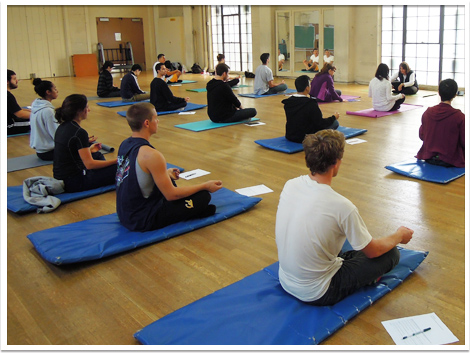
BACKED BY RESEARCH
Multiple dedicated studies have been done on the practice of Tamarkoz® at places such as UC Berkeley and Kaiser Permanente.
Tamarkoz is recommended by medical doctors, psychologists, public health researchers, and thousands of practitioners who have benefited from it.
A research study at UC Berkeley shows that Tamarkoz significantly decreases heart rate and perceived stress, while significantly increases positive emotions (joy, love, compassion, amusement, awe, contentment), and daily spiritual experiences compared to another group utilizing stress management resources and a control group.1

A study at Kaiser Permanente with patients who had recently undergone a serious cardiac event (such as heart attack, bypass surgery or angioplasty) showed a statistically significant decline in depression amongst participants of Tamarkoz. Additionally, reports from the cardiology department suggested reduced utilization of medical services from participants in the study.2
Another study focused on the effects of Tamarkoz® practice on emotional state and DNA repair efficiency, which has tremendous implications for the development of breast cancer. Results from the study indicated that those with greater amounts of daily Tamarkoz practice showed lower levels of emotional distress and highly functional DNA repair efficiency.3
In addition, the techniques used in Tamarkoz have been shown to relieve both psychological and physiological tensions 4, improve cognitive processes 5, enhance sleep, reduce pain, and increase creativity 6.
1. Bahadorani, N. (2017). Implications of Tamarkoz® on increasing spirituality, positive emotions, and reducing stress for university students. Loma Linda University, School of Public Health.
2. Crumpler, C. (2005). Tamarkoz (Sufi meditation) for heart patients: A pilot study.” Sufism: Science of the Soul; 7(1): 9-10.Crumpler, Cheryl. 2005. “Tamarkoz (Sufi Meditation) for Heart Patients: A Pilot Study.” Sufi Psychology Journal: Science of the Soul 7 (1): 9-10.
3. Crumpler, C. (2002). Sufi practices, emotional state, and DNA repair: Implications for breast cancer. Sufism, Science of the Soul; 4(1): 25-37.
4. Vlemincx, E., Van Diest, I., Van den Bergh, O. (2016). A sigh of relief or a sigh to relieve: The psychological and physiological relief effect of deep breaths. Physiology & Behavior; 165: 127-135.
5. Soni, S., Joshi., L. N., & Datta, A. (2015). Effect of controlled deep breathing on psychomotor and higher mental functions in normal individuals. Indian Journal of Physiology & Pharmocology; 59(1): 41-47.
6. Hoffart, M. B. (1999). The benefits of visualization. The American Journal of Nursing; 98(12): 44-47.
Related Information
And you? When will you begin that long journey into yourself?
Rumi-13th century Sufi poet
